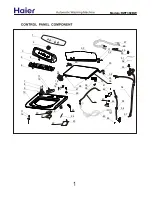
3. Select the required options by pressing
the relevant buttons.
If possible, do not select a spin
speed lower than that proposed by
the appliance to avoid too long a dry-
ing time therefore saving energy.
In any case the reduction of the spin
speed is only possible after selecting dry-
ing.
The lowest values you can select are
900 r.p.m. for cottons and synthetics
and 700 r.p.m. for delicate fabrics.
4. Set the drying time by pressing button
6
. The display shows the whole dura-
tion of the washing and the set drying cy-
cle.
5. Start the programme by pressing button
8
. The time remaining is updated every
minute on the display.
6. At the end of the programme turn the se-
lector dial to the
O
position to switch the
machine off and remove the laundry.
HELPFUL HINTS AND TIPS
Sorting out the laundry
Follow the wash code symbols on each gar-
ment label and the manufacturer’s washing
instructions. Sort the laundry as follows:
whites, coloureds, synthetics, delicates,
woollens.
Before loading the laundry
Never wash whites and coloureds together.
Whites may lose their «whiteness» in the
wash.
New coloured items may run in the first
wash; they should therefore be washed sep-
arately the first time.
Button up pillowcases, close zip fasteners,
hooks and poppers. Tie any belts or long
tapes.
Remove persistent stains before washing.
Rub particularly soiled areas with a special
detergent or detergent paste.
Treat curtains with special care. Remove
hooks or tie them up in a bag or net.
Removing stains
Stubborn stains may not be removed by
just water and detergent. It is therefore ad-
visable to treat them prior to washing.
Blood:
treat fresh stains with cold water.
For dried stains, soak overnight in water
with a special detergent then rub in the
soap and water.
Oil based paint:
moisten with benzine
stain remover, lay the garment on a soft
cloth and dab the stain; treat several times.
Dried grease stains:
moisten with turpen-
tine, lay the garment on a soft surface and
dab the stain with the fingertips and a cot-
ton cloth.
Rust:
oxalic acid dissolved in hot water or a
rust removing product used cold. Be careful
with rust stains which are not recent since
the cellulose structure will already have
been damaged and the fabric tends to hole.
Mould stains:
treat with bleach, rinse well
(whites and fast coloureds only).
Grass:
soap lightly and treat with bleach
(whites and fast coloureds only).
Ball point pen and glue:
moisten with ace-
tone
3)
, lay the garment on a soft cloth and
dab the stain.
Lipstick:
moisten with acetone as above,
then treat stains with methylated spirits.
Treat any residual marks with bleach.
Red wine:
soak in water and detergent,
rinse and treat with acetic or citric acid,
then rinse. Treat any residual marks with
bleach.
Ink:
depending on the type of ink, moisten
the fabric first with acetone
3)
, then with ace-
tic acid; treat any residual marks on white
fabrics with bleach and then rinse thorough-
ly.
Tar stains:
first treat with stain remover, me-
thylated spirits or benzine, then rub with de-
tergent paste.
Detergents and additives
Good washing results also depend on the
choice of detergent and use of the correct
quantities to avoid waste and protect the en-
vironment.
Although biodegradable, detergents contain
substances which, in large quantities, can
upset the delicate balance of nature.
3) do not use acetone on artificial silk
electrolux
77
Summary of Contents for EWW 127470 W
Page 95: ...electrolux 95 ...
















































